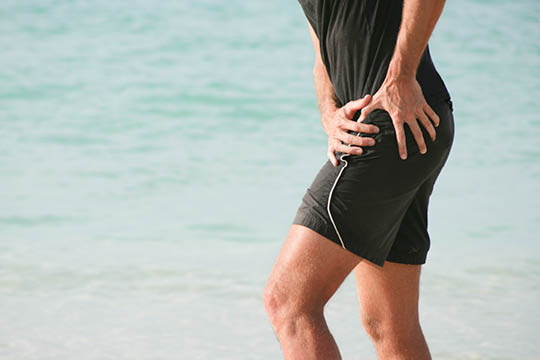Sacroilliac joint (SIJ) inflammation is a condition that involves arthritic changes or inflammatory responses from local injury or systemic inflammatory conditions that may be either inherited or acquired. Inflammation is the body’s response to an injury or a disease that is present. Inflammation can increase muscle spasm, compression of nerves and generalised discomfort that will tend to be worse in the morning.
--What causes sacroilliac joint inflammation?
SIJ inflammation may occur with high-impact accidents, including car accidents and general trauma to the area following a fall. High-volume labouring, gardening, lifting or overload with pushing or pulling tasks can result in repetitive loading of the joint, which results in inflammation. Some individuals may have inherited or acquired inflammatory disorders (eg, ankylosing spondylitis or psoriatic arthritis). Symptoms for these conditions tend to show signs, initially in the SIJ region, which progress to other areas throughout the spine.
--How do I know if I have sacroilliac joint inflammation?
The most intense pain is generally felt in the middle of the night when sleeping, typically between 2.00 m to 5.00 am. Pain is related to stiffness in the area and occasionally felt as a hot or burning feeling. Prolonged static postures, such as standing and sitting, are the most common factors that make pain worse. Pain will tend to remain constant throughout the day. Over-the-counter anti-inflammatories may help in the short term. This condition is most commonly found in males (63 per cent) but will only occur in 7.9 per cent of sacroiliac joint dysfunction sufferers, as demonstrated in a study conducted by Arthritis Care in 2010.
--How can physiotherapy help with sacroilliac joint inflammation?
Physiotherapy is a key component of a comprehensive rehabilitation program, in conjunction with your GP, who will prescribe the correct anti-inflammatory medication or SIJ anti-inflammatory injections. This will enable a return to work, life and sporting activities. Once the anti-inflammatory strategies have relieved the initial onset of symptoms, physiotherapy will aim to increase mobility through the lumbopelvic and hip region, as well as building strength and control through the hip to unload the pelvis and lumbar spine.
--How effective is physiotherapy for sacroilliac joint inflammation?
The first course of action for SIJ inflammation is an effective medical strategy to manage the intra-articular pain and swelling that occurs in this condition. If your pain is most severe at night, it is important to speak to your physiotherapist regarding a visit to your GP for effective medication prior to commencing a rehabilitation program. Once the medication has settled the acute signs, physiotherapy is very effective in promoting mobility and strength through the hips, pelvis and lumbar spine to protect the region from dynamic repetitive loading.
--What can I do at home?
Lying on your back or side with your hips bent up in a foetal position at night, or when your pain is aggravated, may help ease the symptoms. Using ice packs on the inflamed area may also help. Gentle unloaded movement, such as walking forward, backward and sideways in a pool, may help to relieve symptoms and muscle spasm in the area. Gentle stretches and massage to gluteal muscles may help unload the inflamed SIJ and decrease protective muscle spasm.
--How long until I feel better?
It is important that the correct medication to target the specific origin of the inflammation is identified. This may come from your GP, or, if it is suspected that the inflammation is more from a systemic problem, you may first be sent to a rheumatologist for a specialist opinion. Once the correct medication has been identified, symptoms should start to settle in 2-4 weeks. It is at this time that comprehensive physiotherapy, combining mobility work to joints, and a progressed functional strength program, can help you return to normal work, life and sporting activities.

